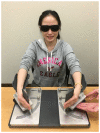Age-Related Decline of Wrist Position Sense and its Relationship to Specific Physical Training
- PMID: 29209188
- PMCID: PMC5702425
- DOI: 10.3389/fnhum.2017.00570
Age-Related Decline of Wrist Position Sense and its Relationship to Specific Physical Training
Abstract
Perception of limb and body positions is known as proprioception. Sensory feedback, especially from proprioceptive receptors, is essential for motor control. Aging is associated with a decline in position sense at proximal joints, but there is inconclusive evidence of distal joints being equally affected by aging. In addition, there is initial evidence that physical activity attenuates age-related decline in proprioception. Our objectives were, first, to establish wrist proprioceptive acuity in a large group of seniors and compare their perception to young adults, and second, to determine if specific types of training or regular physical activity are associated with preserved wrist proprioception. We recruited community-dwelling seniors (n = 107, mean age, 70 ± 5 years, range, 65-84 years) without cognitive decline (Mini Mental State Examination-brief version ≥13/16) and young adult students (n = 51, mean age, 20 ± 1 years, range, 19-26 years). Participants performed contralateral and ipsilateral wrist position sense matching tasks with a bimanual wrist manipulandum to a 15° flexion reference position. Systematic error or proprioceptive bias was computed as the mean difference between matched and reference position. The respective standard deviation over five trials constituted a measure of random error or proprioceptive precision. Current levels of physical activity and previous sport, musical, or dance training were obtained through a questionnaire. We employed longitudinal mixed effects linear models to calculate the effects of trial number, sex, type of matching task and age on wrist proprioceptive bias and precision. The main results were that relative proprioceptive bias was greater in older when compared to young adults (mean difference: 36% ipsilateral, 88% contralateral, p < 0.01). Proprioceptive precision for contralateral but not for ipsilateral matching was smaller in older than in young adults (mean difference: 38% contralateral, p < 0.01). Longer years of dance training were associated with smaller bias during ipsilateral matching (p < 0.01). Other types of training or physical activity levels did not affect bias or precision. Our findings demonstrate that aging is associated with a decline in proprioceptive bias in distal arm joints, but age does not negatively affect proprioceptive precision. Further, specific types of long-term dance related training may attenuate age-related decline in proprioceptive bias.
Keywords: adult; dancing; exercise; human; position sense; proprioception; sensorimotor; wrist.
Figures






Similar articles
-
Development of Proprioceptive Acuity in Typically Developing Children: Normative Data on Forearm Position Sense.Front Hum Neurosci. 2016 Aug 29;10:436. doi: 10.3389/fnhum.2016.00436. eCollection 2016. Front Hum Neurosci. 2016. PMID: 27621702 Free PMC article.
-
Upper limb proprioception and fine motor function in young pianists.Hum Mov Sci. 2021 Feb;75:102748. doi: 10.1016/j.humov.2020.102748. Epub 2020 Dec 22. Hum Mov Sci. 2021. PMID: 33360200
-
Robot-Assisted Proprioceptive Training with Added Vibro-Tactile Feedback Enhances Somatosensory and Motor Performance.PLoS One. 2016 Oct 11;11(10):e0164511. doi: 10.1371/journal.pone.0164511. eCollection 2016. PLoS One. 2016. PMID: 27727321 Free PMC article.
-
Impaired limb position sense after stroke: a quantitative test for clinical use.Arch Phys Med Rehabil. 1996 Dec;77(12):1271-8. doi: 10.1016/s0003-9993(96)90192-6. Arch Phys Med Rehabil. 1996. PMID: 8976311 Review.
-
Proprioception in patients with posterior cruciate ligament tears: A meta-analysis comparison of reconstructed and contralateral normal knees.PLoS One. 2017 Sep 18;12(9):e0184812. doi: 10.1371/journal.pone.0184812. eCollection 2017. PLoS One. 2017. PMID: 28922423 Free PMC article. Review.
Cited by
-
Body representation underlies response of proprioceptive acuity to repetitive peripheral magnetic stimulation.Front Hum Neurosci. 2022 Aug 9;16:924123. doi: 10.3389/fnhum.2022.924123. eCollection 2022. Front Hum Neurosci. 2022. PMID: 36016664 Free PMC article.
-
Robot-aided assessment and associated brain lesions of impaired ankle proprioception in chronic stroke.J Neuroeng Rehabil. 2024 Jun 24;21(1):109. doi: 10.1186/s12984-024-01396-9. J Neuroeng Rehabil. 2024. PMID: 38915064 Free PMC article.
-
Anodal Transcranial Direct Current Stimulation Over S1 Differentially Modulates Proprioceptive Accuracy in Young and Old Adults.Front Aging Neurosci. 2019 Sep 26;11:264. doi: 10.3389/fnagi.2019.00264. eCollection 2019. Front Aging Neurosci. 2019. PMID: 31611782 Free PMC article.
-
Cervical Proprioception Assessed through Targeted Head Repositioning: Validation of a Clinical Test Based on Optoelectronic Measures.Brain Sci. 2023 Apr 2;13(4):604. doi: 10.3390/brainsci13040604. Brain Sci. 2023. PMID: 37190569 Free PMC article.
-
The effect of age on ankle joint position sense differs between contralateral matching and ipsilateral reproduction tasks.Exp Brain Res. 2025 Feb 28;243(4):78. doi: 10.1007/s00221-025-06999-9. Exp Brain Res. 2025. PMID: 40019517
References
Grants and funding
LinkOut - more resources
Full Text Sources
Other Literature Sources
Miscellaneous

